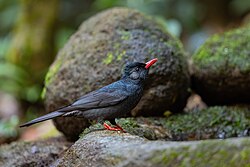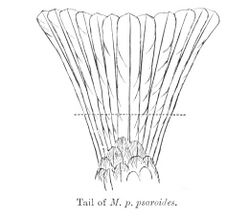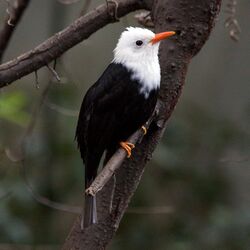Biology:Black bulbul
| Black bulbul | |
|---|---|

| |
| Scientific classification | |
| Domain: | Eukaryota |
| Kingdom: | Animalia |
| Phylum: | Chordata |
| Class: | Aves |
| Order: | Passeriformes |
| Family: | Pycnonotidae |
| Genus: | Hypsipetes |
| Species: | H. leucocephalus
|
| Binomial name | |
| Hypsipetes leucocephalus (Gmelin, JF, 1789)
| |
| Synonyms | |
| |
The black bulbul (Hypsipetes leucocephalus), also known as the Himalayan black bulbul or Asian black bulbul, is a member of the bulbul family of passerine birds. It is found primarily in the Himalayas, its range stretching from India eastward to Southeast Asia. It is the type species of the genus Hypsipetes, established by Nicholas Aylward Vigors in the early 1830s.[2] There are a number of subspecies, mostly varying in the shade of the body plumage which ranges from grey to black, and some also occur in white-headed morphs, as also suggested by its specific epithet leucocephalus, literally "white head". The legs and bill are always rich orange-red.
Taxonomy and systematics
The black bulbul was formally described in 1789 by the German naturalist Johann Friedrich Gmelin in his revised and expanded edition of Carl Linnaeus's Systema Naturae. He placed it with the thrushes in the genus Turdus and coined the binomial name Turdus leucocephalus.[3] Gmelin based his account on "Le Merle Dominiquain de la Chine", a white-headed morph from China that had been described in 1782 by the French naturalist Pierre Sonnerat.[4] The type locality was subsequently restricted to Guangzhou (formerly Canton) in China.[5] The black bulbul is now one of 19 species placed in the genus Hypsipetes that was introduced in 1831 by the Irish zoologist Nicholas Vigors.[6] The genus name combines the Ancient Greek hupsi meaning "high" with petēs meaning "-flyer". The specific epithet leucocephalus is from Ancient Greek leukokephalos meaning "white-headed" (from leukos "white" and -kephalos "-headed").[7] The black bulbul was formerly considered to be conspecific with the Malagasy bulbul.[5][8] The common name "black bulbul" is also used as an alternate name for the Malagasy bulbul. Formerly, the square-tailed bulbul was also classified as two subspecies of the black bulbul.
Subspecies
Ten subspecies are currently recognized, although the reproductive isolation mechanisms such as vocalization and geographic distributions of these populations still remain to be studied:[6][9]
- H. l. psaroides - Vigors, 1831: Originally described as a separate species. Found along the Himalayas from the Kunar Valley (north-eastern Afghanistan) and northern Pakistan through Arunachal Pradesh (northern India) and the central Himalayas to north-western Myanmar
- Assam black bulbul (H. l. nigrescens) - Baker, ECS, 1917: Found in Assam and Manipur (north-eastern India), and the Chin Hills (western Myanmar)
- Burmese black bulbul (H. l. concolor) - Blyth, 1849: Originally described as a separate species. Found from eastern Myanmar and southern Yunnan (southern China) through Indochina
- H. l. ambiens - (Mayr, 1942): Found in north-eastern Myanmar and western Yunnan (southern China)
- H. l. sinensis - (La Touche, 1922): Found in northern Yunnan (southern China)
- H. l. stresemanni - (Mayr, 1942): Members of this race have white heads. Found in central Yunnan (southern China)
- H. l. leucothorax - (Mayr, 1942): Members of this race have white heads. Found in central China
- H. l. leucocephalus - (Gmelin, JF, 1789): Members of this race have white heads. Found in south-eastern China
- H. l. nigerrimus - (Gould, 1863): Originally described as a separate species. Found in Taiwan
- H. l. perniger - Swinhoe, 1870: Originally described as a separate species. Found on Hainan Island (off south-eastern China)
Description
The black bulbul is 24–25 cm (9.4–9.8 in) in length, with a long tail. The body plumage ranges from slate grey to shimmering black, depending on the race. The beak, legs, and feet are all orange and the head has a black fluffy crest. Sexes are similar in plumage, but young birds lack the crest, have whitish underparts with a grey breast band, and have a brown tint to the upperparts. They have a black streak behind the eye and on the ear coverts.[10][11][12] Although males and females are indistinguishable to the human eye, there are significant differences in the ultraviolet reflectivity of the plumage making them readily distinguishable to the bulbuls themselves.[13]
Vocalisations
They can be quite noisy, making various loud cheeping, mewing and grating calls.[10] The Himalayan form has been reported to make a call resembling a goat kid, throwing back its neck when calling.[14]
Distribution and habitat
This bulbul is found in broad-leaved forests, cultivation and gardens mainly in hilly areas, but Himalayan populations are known to sometimes descend into the adjoining plains in winter.[15][16][17]
Breeding
It builds its nest in a tree or bush; the nest is a cup placed in a fork and made from grasses, dry leaves, mosses, lichens and cobwebs. The lining is made up of ferns, rootlets and other soft material.[18] Both sexes participate in nest construction. Two or three eggs form the usual clutch.
Food and feeding
Black bulbuls feed mainly on seeds and insects, and they are often seen in small groups, either roosting or flying about in search of food. They are particularly fond of berries. They are known to feed on a wide range of berries including Celtis, Rosa, Melia and Ehretia in the Himalayas.[19] They feed on the nectar of Salmalia, Erythrina, Rhododendron and other species. They make aerial sallies for insects.[15]
References
- ↑ BirdLife International (2016). "Hypsipetes leucocephalus". IUCN Red List of Threatened Species 2016: e.T103823996A94366953. doi:10.2305/IUCN.UK.2016-3.RLTS.T103823996A94366953.en. https://www.iucnredlist.org/species/103823996/94366953. Retrieved 19 November 2021.
- ↑ Gregory, Steven M. S. (2000). "Nomenclature of the Hypsipetes Bulbuls (Pycnonotidae)". Forktail 16: 164–166. https://static1.squarespace.com/static/5c1a9e03f407b482a158da87/t/5c1fc53f4fa51a05054b7013/1545585983976/Gregory-Bulbuls.pdf.
- ↑ Gmelin, Johann Friedrich (1789) (in Latin). Systema naturae per regna tria naturae : secundum classes, ordines, genera, species, cum characteribus, differentiis, synonymis, locis. 1, Part 2 (13th ed.). Lipsiae [Leipzig]: Georg. Emanuel. Beer. p. 829. https://www.biodiversitylibrary.org/page/2656324.
- ↑ Sonnerat, Pierre (1782) (in French). Voyage aux Indes orientales et a la Chine, fait par ordre du Roi, depuis 1774 jusqu'en 1781. 2. Paris: Chez l'Auteur. pp. 191-192. https://gallica.bnf.fr/ark:/12148/bpt6k15182388/f276.item.
- ↑ Jump up to: 5.0 5.1 Mayr, Ernst; Greenway, James C. Jr, eds (1960). Check-List of Birds of the World. 9. Cambridge, Massachusetts: Museum of Comparative Zoology. p. 298. https://www.biodiversitylibrary.org/page/14480973.
- ↑ Jump up to: 6.0 6.1 Gill, Frank; Donsker, David; Rasmussen, Pamela, eds (January 2023). "Bulbuls". IOC World Bird List Version 13.1. International Ornithologists' Union. https://www.worldbirdnames.org/bow/bulbuls/.
- ↑ Jobling, James A. (2010). The Helm Dictionary of Scientific Bird Names. London: Christopher Helm. pp. 200, 223. ISBN 978-1-4081-2501-4.
- ↑ Warren, Ben H.; Bermingham, Eldredge; Prys-Jones, Robert P.; Thebaud, Christophe (2005). "Tracking island colonization history and phenotypic shifts in Indian Ocean bulbuls (Hypsipetes: Pycnonotidae)". Biological Journal of the Linnean Society 85 (3): 271–287. doi:10.1111/j.1095-8312.2005.00492.x. https://repository.si.edu/bitstream/handle/10088/3988/Warren_Bermingham_Prys-Jones_and_Thebaud_2005.pdf?sequence=1&isAllowed=y.
- ↑ Dickinson, E.C.; Dekker, R.W.R.J.; Eck, S.; Somadikarta, S. (2002). "Systematic notes on Asian birds. 26. Types of the Pycnonotidae". Zool. Verh. Leiden 340: 115–160. https://www.repository.naturalis.nl/document/46724.
- ↑ Jump up to: 10.0 10.1 Ali, S; S D Ripley (1996). Handbook of the birds of India and Pakistan. 6 (2nd ed.). Oxford University Press. pp. 109–113.
- ↑ Blanford WT (1889). The Fauna of British India, Including Ceylon and Burma: Birds Volume 1. Taylor and Francis, London. pp. 259–263. https://archive.org/stream/birdsindia01oaterich#page/260/mode/1up/.
- ↑ Baker, ECS (1924). The Fauna of British India, Including Ceylon and Burma. Birds. 1 (2nd ed.). Taylor and Francis, London. pp. 368–373. https://archive.org/stream/faunaofbritishin01bake#page/369/mode/1up/.
- ↑ Hung, Hsin-Yi; Yeung, Carol K. L.; Omland, Kevin E.; Yao, Cheng-Te; Yao, Chiou-Ju; Li, Shou-Hsien (2017). "Himalayan black bulbuls (Hypsipetes leucocephalus niggerimus) exhibit sexual dichromatism under ultraviolet light that is invisible to the human eye" (in en). Scientific Reports 7 (1): 43707. doi:10.1038/srep43707. ISSN 2045-2322. PMID 28382942.
- ↑ Page, WT (1903). "The Himalayan Black Bulbul. Hypsipetes psaroides". Avicultural Magazine 1 (6): 209–211. https://archive.org/stream/aviculturalmagaz01avic#page/209/mode/1up.
- ↑ Jump up to: 15.0 15.1 Rasmussen PC; JC Anderton (2005). Birds of South Asia. The Ripley Guide. Volume 2. Smithsonian Institution & Lynx Edicions. pp. 342–344.
- ↑ Raza, Rashid H. (1993). "Sighting of Black Bulbul Hypsipetes madagascariensis (P.L.S. Muller) in Gaya, Bihar". Journal of the Bombay Natural History Society 90 (2): 291. https://biodiversitylibrary.org/page/48609546.
- ↑ Gaston, AJ (1972). "Black Bulbuls Hypsipetes madagascariensis (P.L.S. Muller) in Delhi". Journal of the Bombay Natural History Society 69 (3): 651–652. https://biodiversitylibrary.org/page/48289642.
- ↑ Hume, A.O. (1889). The nests and eggs of Indian birds. 1 (2nd ed.). R H Porter, London. pp. 164–168. https://archive.org/stream/nestseggsofindia01humerich#page/164/mode/1up/.
- ↑ Narang, ML; Rana, RS (1999). "Black Bulbuls association with Melia azedarach". Newsletter for Birdwatchers 38 (6): 104. https://archive.org/stream/NLBW38_6#page/n15/mode/1up/.
Wikidata ☰ Q998240 entry
 |




